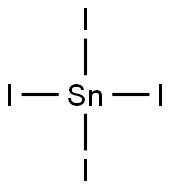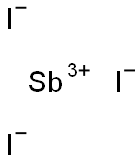TIN(IV) IODIDE
Synonym(s):Stannic iodide
- CAS NO.:7790-47-8
- Empirical Formula: I4Sn
- Molecular Weight: 626.33
- MDL number: MFCD00036272
- EINECS: 232-208-4
- SAFETY DATA SHEET (SDS)
- Update Date: 2025-01-27 09:38:02

What is TIN(IV) IODIDE?
Chemical properties
Brown powder
The Uses of TIN(IV) IODIDE
Tin(IV) iodide is used in the preparation of tin(IV) oxide and tin(II) oxide. It reacts with hydroiodic acid to get rare tin hexaiodide. It forms tetraiodobis triphenylphosphine tin complexes by reacting with triphenylphosphine, which finds application in toothpaste formulation. Further, it acts as analytical reagents and also used in organic synthesis.
Safety Profile
Poison by intravenous route. Strong reaction with N02Cl, (K+ S), (Na + S). When heated to decomposition it emits toxic fumes of I-. See also TIN COMPOUNDS and IODIDES.
Purification Methods
It is recrystallised from anhydrous CHCl3, dry it under vacuum and store it in a vacuum desiccator. It sublimes at 180o.
Properties of TIN(IV) IODIDE
| Melting point: | 144 °C |
| Boiling point: | 364 °C |
| Density | 4.47 g/mL at 25 °C(lit.) |
| refractive index | 2.106 |
| Flash point: | 340°C |
| solubility | Soluble in alcohol, benzene, carbon disulfide, chloroform and ether. |
| form | powder |
| color | Red |
| Specific Gravity | 4.473 |
| Water Solubility | Soluble in alcohol, benzene, CS{2}, chloroform, and ether. Decomposes in water |
| Sensitive | Moisture Sensitive |
| Hydrolytic Sensitivity | 8: reacts rapidly with moisture, water, protic solvents |
| Merck | 14,8777 |
| Exposure limits | ACGIH: TWA 2 mg/m3 NIOSH: IDLH 100 mg/m3; TWA 2 mg/m3 |
| CAS DataBase Reference | 7790-47-8(CAS DataBase Reference) |
| EPA Substance Registry System | Stannane, tetraiodo- (7790-47-8) |
Safety information for TIN(IV) IODIDE
| Signal word | Danger |
| Pictogram(s) |
 Corrosion Corrosives GHS05  Exclamation Mark Irritant GHS07  Health Hazard GHS08 |
| GHS Hazard Statements |
H314:Skin corrosion/irritation H317:Sensitisation, Skin H334:Sensitisation, respiratory |
| Precautionary Statement Codes |
P260:Do not breathe dust/fume/gas/mist/vapours/spray. P280:Wear protective gloves/protective clothing/eye protection/face protection. P301+P312:IF SWALLOWED: call a POISON CENTER or doctor/physician IF you feel unwell. P303+P361+P353:IF ON SKIN (or hair): Remove/Take off Immediately all contaminated clothing. Rinse SKIN with water/shower. P305+P351+P338:IF IN EYES: Rinse cautiously with water for several minutes. Remove contact lenses, if present and easy to do. Continuerinsing. |
Computed Descriptors for TIN(IV) IODIDE
New Products
3-Iodophenylacetic acid 3-Pyridineacetonitrile, α-hydroxy- 2-Propanamine, 1-chloro-, hydrochloride (9CI) 3-(hexyloxy)-4-(pyridin-3-yl)-1,2,5-thiadiazole 2-Hexyn-1-ol Dibenzo-18-crown-6 Nickel(II) perchlorate hexahydrate, 98% 4-Bromophenylacetonitrile, 95% 3-Bromo-4-fluoroaniline, 97% Sodium tetraborate decahydrate, 98% Palladium(II) acetate, trimer, Pd 99% 4-Bromo-2-chlorotoluene, 97% N N Dimethylformamide Dimethyl Acetal (Dmf Dma) 2,3-Dichloro Benzoyl Cyanide [Side Chain] Bis(2-Chloroethyl) Amine Hydrochloride L-Glutamic Acid Diethyl Ester Hydrochloride 5-(Difluoromethoxy)-2-Mercaptobenzimidazole 1-Ethyl-3-(3-Dimethylaminopropyl)-Carbodiimide Hydrochloride [EDC Hcl] 1,4-Napthoquinone Bromoiodomethane Sodium Bicarbonate Methylene Dichloride (MDC) Ethyl Acetate Indole-3-Carbinol (I3C)Related products of tetrahydrofuran








You may like
-
 Tin (IV) iodide CAS 7790-47-8View Details
Tin (IV) iodide CAS 7790-47-8View Details
7790-47-8 -
 Tin(iv) iodide 95% CAS 7790-47-8View Details
Tin(iv) iodide 95% CAS 7790-47-8View Details
7790-47-8 -
 Tin(IV) iodide CAS 7790-47-8View Details
Tin(IV) iodide CAS 7790-47-8View Details
7790-47-8 -
 17604-74-9 3-Pyridineacetonitrile, α-hydroxy- 98+View Details
17604-74-9 3-Pyridineacetonitrile, α-hydroxy- 98+View Details
17604-74-9 -
 Cyclohexane, (2-propynyloxy)- 67967-07-1 98+View Details
Cyclohexane, (2-propynyloxy)- 67967-07-1 98+View Details
67967-07-1 -
 2-Propanamine, 1-chloro-, hydrochloride (9CI) 98+View Details
2-Propanamine, 1-chloro-, hydrochloride (9CI) 98+View Details
5968-21-8 -
 3-Iodophenylacetic acid 1878-69-9 98+View Details
3-Iodophenylacetic acid 1878-69-9 98+View Details
1878-69-9 -
 132945-75-6 (S)-1-Boc-3-methanesulfonyloxy-pyrrolidine 98+View Details
132945-75-6 (S)-1-Boc-3-methanesulfonyloxy-pyrrolidine 98+View Details
132945-75-6
Statement: All products displayed on this website are only used for non medical purposes such as industrial applications or scientific research, and cannot be used for clinical diagnosis or treatment of humans or animals. They are not medicinal or edible.
